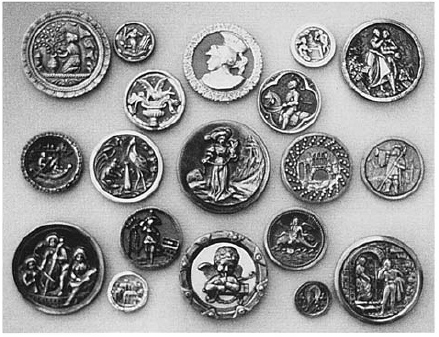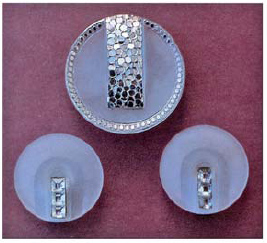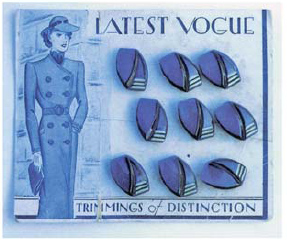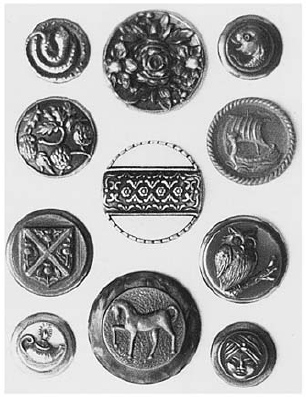Buttons (4 page)
Metal buttons with back marks of French button-makers, known by collectors as ‘Paris backs’.
The fashion for ultra-plain, simple lines with fewer buttons prevailed in women’s clothing after the First World War. Swathed-style coats were fastened with one or two large buttons at the neck or hip. The skimpy buttonless underwear caused outrage among older people, who still wore flannel petticoats and long Johns. During the late 1920s and 1930s, sensual designs of the Art Nouveau style gave way to the stark, angular appearance of Art Deco. Although brightly coloured buttons of geometric design were eye-catching, maintaining their true alignment and essential juxtaposition on the garment must have been a problem. The fashion was short-lived.
The Second World War brought rationing, and the use of cloth and the number of buttons per manufactured garment were severely restricted, prompting much restyling of outdated garments. In the years immediately following the war manufacturing restrictions continued, encouraging small-scale production of decorative buttons. Hand-pressed glass buttons were made by various enterprises, such as Bimini, for whom Dame Lucie Rie worked.

A selection of black pressed, dyed horn buttons.

A selection of buttons in the Art Nouveau style, various materials.

A selection of metal picture buttons from the late nineteenth and early twentieth centuries. The button in the middle row, second from the left, depicts an illustration from Aesop’s ‘Fables’.

A selection of Art Deco style buttons of various materials.

More Art Deco style buttons of various materials.
The New Look, launched in 1947, consisting of a long, full, swirling skirt, was well established by the 1950s. To cover all the flounces, a tent-like duster coat became popular, fastened with just one or two very large buttons at the neck.

Art Deco style self-shank, moulded glass buttons.

Art Deco celluloid buttons on their original sales card.

Buttons made by British Artid Plastics for a few years from 1946. The buttons are back-marked ‘Artid Made in England’.

Bimini buttons, pressed glass with a flat metal back plate marked with either the company name and/or their sign, a tree in a flowerpot.

Pottery buttons made by Dame Lucie Rie during the time of her association with Bimini Ltd, some carrying her stylised version of the company tree sign.

Moulded metal buttons made c.1950, the larger sizes of which were used on one-button coats.
At the end of the war demobilised troops were issued with a ‘demob’ suit, over which the working man would wear a belted gaberdine mac. This created a need for large numbers of plain sew-through buttons. By contrast, in the second half of the twentieth century, mass use was made of zips and capped pops and, with a vogue for fastenless, pull-on unisex clothes, fewer and fewer buttons were used. Gold, silver, bronze or pearl-coloured buttons dominated the selection, removing the obligation on manufacturers to produce buttons that matched the colour used in the clothes. This facilitated streamlining in the production of buttons. As a revolt against this uniformity, clothing companies had their own buttons produced, bearing their easily recognised company logo and thereby promoting their own brand of goods.